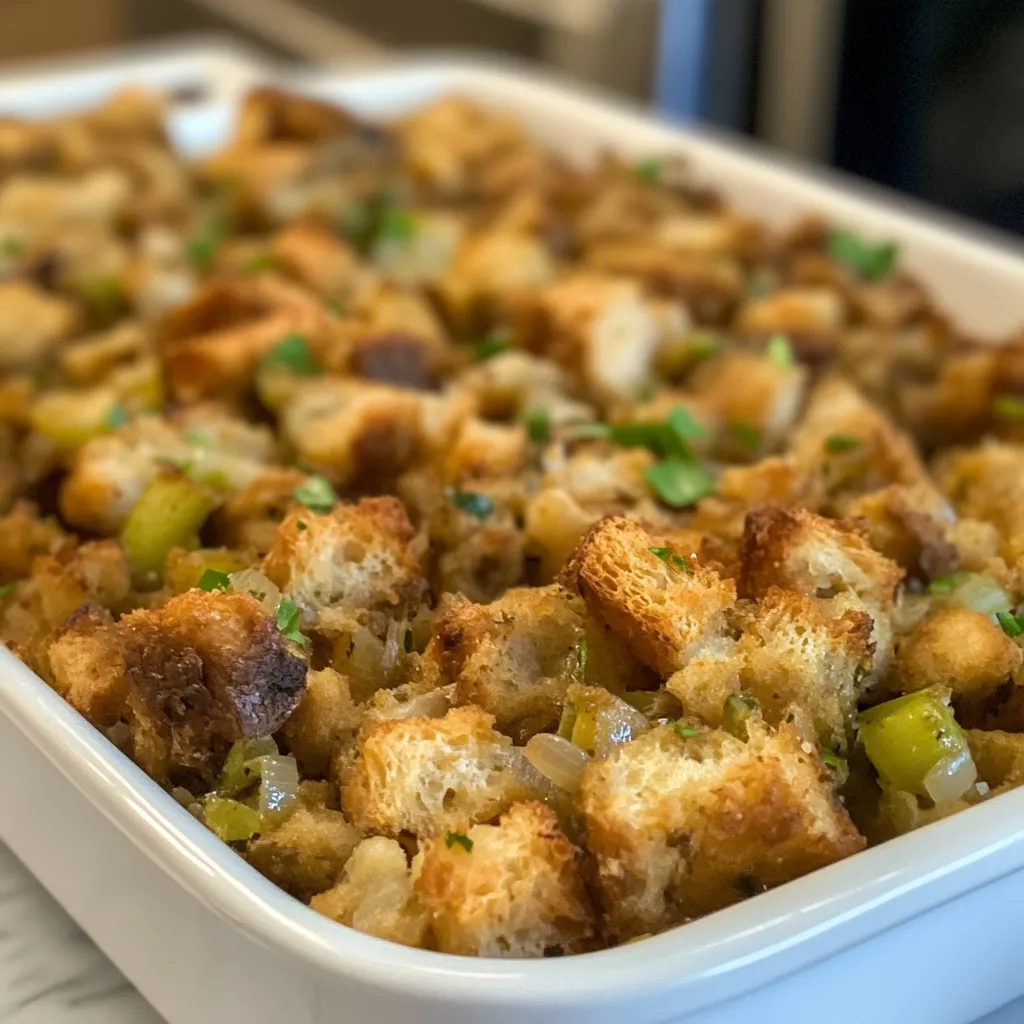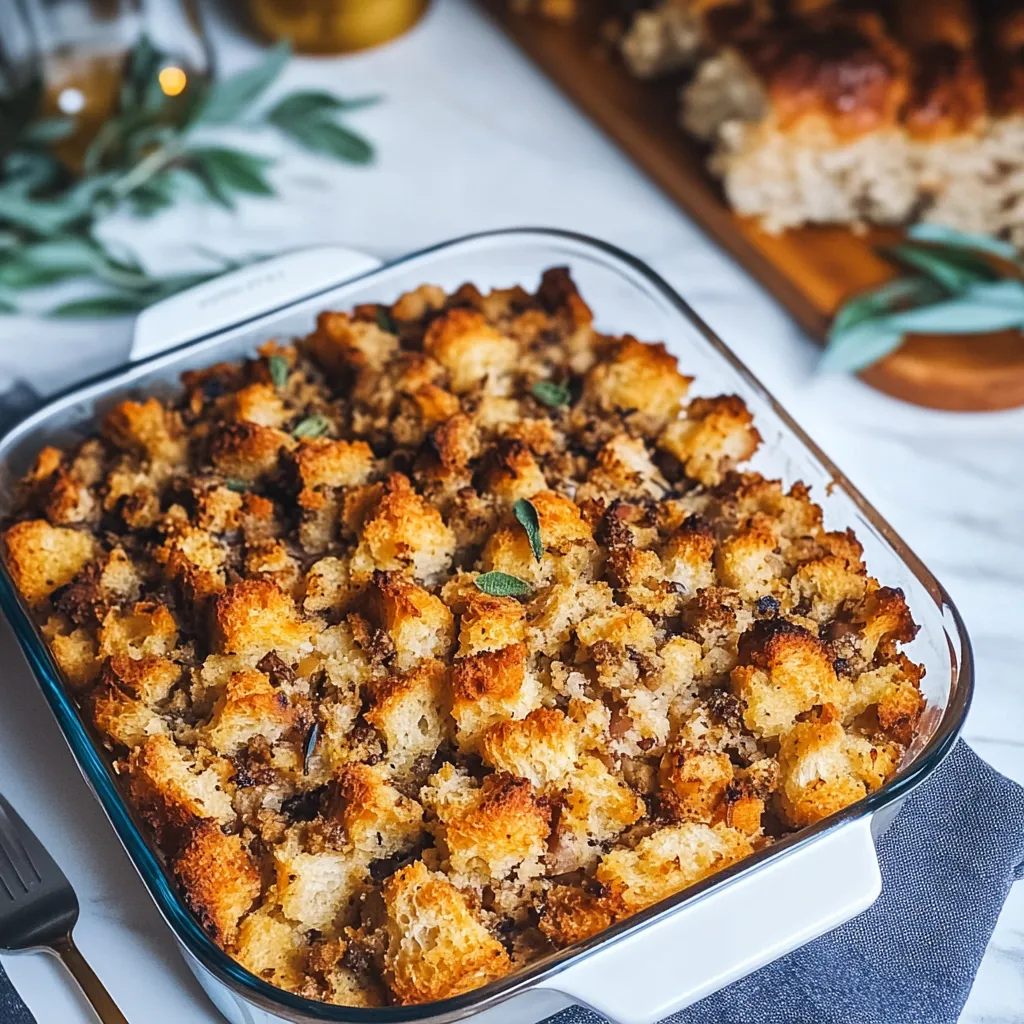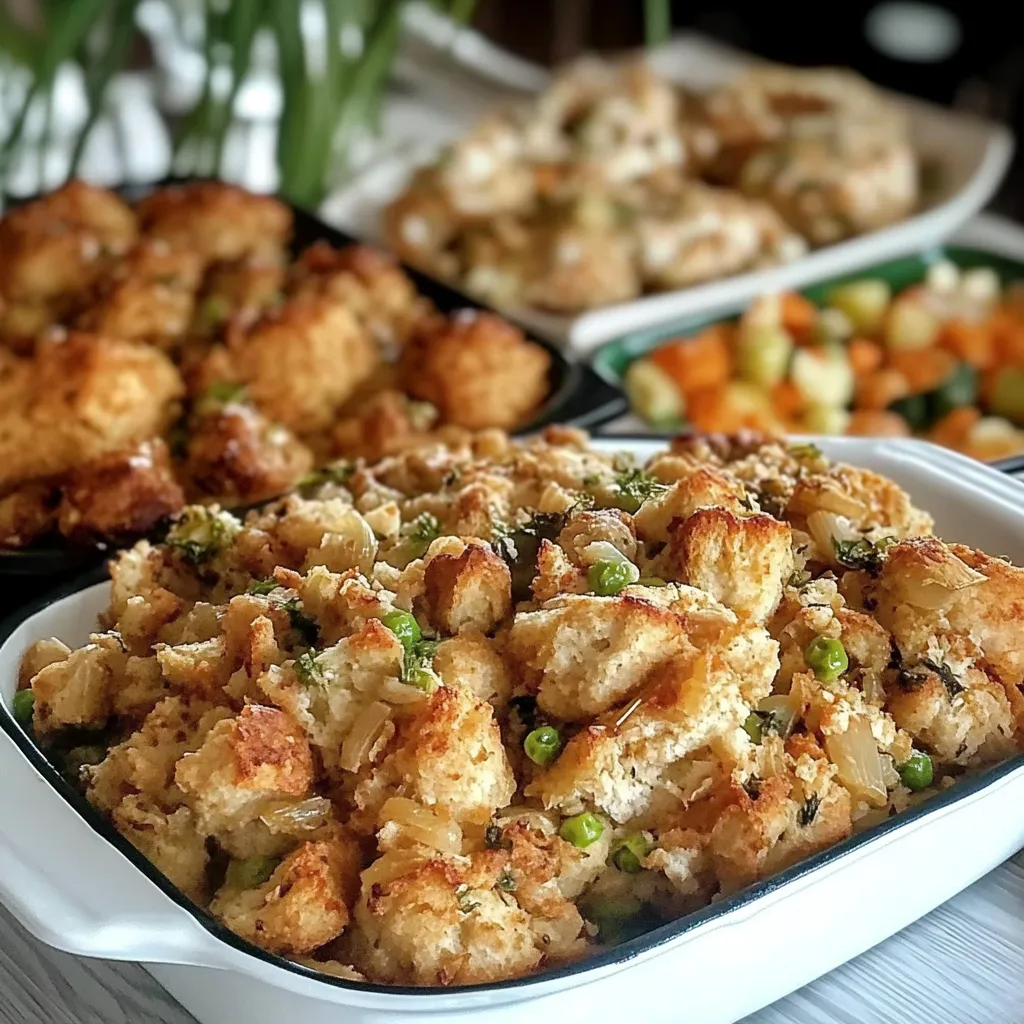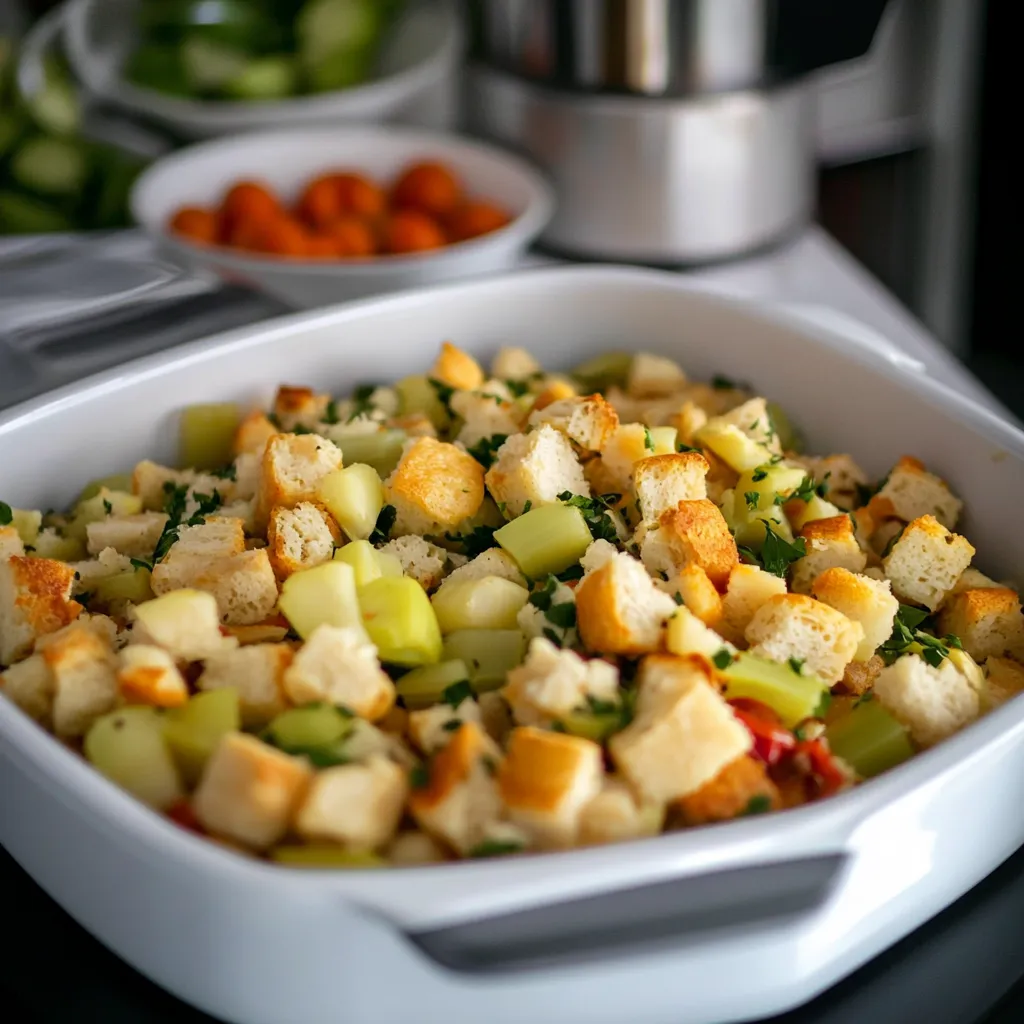When it comes to Thanksgiving, few dishes carry as much tradition and comfort as stuffing. Every family has their own version of this beloved side dish, but there’s something truly special about Grandma’s Thanksgiving Stuffing. This recipe has been handed down through generations, and it’s the stuffing that our family looks forward to the most each year. With a perfect balance of savory, sweet, chewy, and crispy elements, Grandma’s Thanksgiving Stuffing is sure to be the star of your holiday meal.
Whether you’re new to stuffing or looking for a recipe that’s stood the test of time, this version is simple to make, with ingredients that are easy to find yet packed with flavor. From the buttery breadcrumbs to the aromatic blend of herbs, this stuffing brings warmth and love to the table. And if you need to adjust for dietary restrictions or personal preferences, there are plenty of variations to suit your needs.
In this article, we’ll guide you through the ingredients, step-by-step instructions, and some helpful tips and tricks for making Grandma’s Thanksgiving Stuffing recipe. Plus, we’ll answer some common questions about stuffing so you can get it just right every time.

What Makes Grandma’s Thanksgiving Stuffing Special?
Grandma’s stuffing recipe stands out because of its perfect texture and balance of flavors. The bread cubes, soaked in savory chicken stock and blended with onions, celery, and a mixture of herbs like sage and thyme, offer the perfect base. The stuffing is moist without being soggy, with just the right amount of buttery richness. The top becomes slightly crispy, adding a delightful contrast to the softer center.
Ingredients:
-
Dry Bread Cubes: The base of any good stuffing. Homemade or store-bought, you want your bread cubes to be slightly dried to absorb the broth without becoming mushy.
-
Butter: Adds richness and flavor. You can use salted or unsalted butter, depending on your preference.
-
Onion & Celery: Essential vegetables for flavor and texture, creating a savory backbone to the stuffing.
-
Poultry Seasoning & Fresh Herbs: Thyme, sage, and parsley bring a delightful herbaceous touch. Poultry seasoning ties it all together.
-
Chicken Stock: Provides moisture and deep flavor. You can also use vegetable stock for a vegetarian version.
This stuffing is designed to be made from scratch, but we’ll offer shortcuts that allow you to get it done faster without sacrificing flavor.
Ingredients for Grandma’s Thanksgiving Stuffing
Here’s everything you’ll need for the perfect stuffing:
-
16 cups of dry bread cubes (about 3 large loaves of bread, cut into ½” to ¾” cubes)
-
½ cup butter
-
2 cups onion, diced
-
2 cups celery, diced
-
3 teaspoons poultry seasoning
-
½ teaspoon thyme (fresh chopped or dried)
-
½ teaspoon sage (fresh chopped or dried)
-
1 teaspoon salt
-
½ teaspoon ground black pepper
-
1 ½ cups chicken broth (or vegetable broth for vegetarian)
-
2 large eggs, beaten
-
1 tablespoon fresh parsley, chopped (for garnish)

How to Make Grandma’s Thanksgiving Stuffing
Step 1: Prepare the Bread Cubes
To get the best stuffing, you need to dry out the bread cubes. If you’re using fresh bread, cut it into cubes about ½” to ¾” in size. Spread the cubes out on a baking sheet and bake at 250°F (120°C) for about an hour, tossing them every 15 minutes. You want them crisp and dry but not too hard. Once they’re done, set them aside while you prepare the other ingredients.
Step 2: Sauté the Vegetables
In a large skillet, melt ½ cup of butter over medium heat. Add the onions and celery. Sauté them for about 8 minutes or until they are soft and translucent. This step is crucial, as cooking out the moisture from the vegetables ensures the stuffing doesn’t become soggy. Add poultry seasoning, thyme, sage, salt, and pepper. Stir the herbs and spices into the vegetables for 1-2 minutes until fragrant.
Step 3: Combine with Chicken Stock
Once your vegetables are tender, pour in 1 ½ cups of chicken stock and bring it to a simmer. Allow the mixture to cook for another 2-3 minutes to combine all the flavors. Remove from heat.
Step 4: Mix the Stuffing
In a large bowl, place the dry bread cubes. Pour the vegetable and broth mixture over the bread cubes. Gently fold the ingredients together, ensuring the bread is evenly soaked. Be careful not to crush the bread. The stuffing should be moist, but there should not be any standing liquid at the bottom of the bowl. If needed, add up to ½ cup of additional chicken stock to moisten the mixture.
Step 5: Add the Eggs
In a small bowl, whisk the two eggs and add them to the stuffing mixture. Stir to combine. The eggs help bind the stuffing together, giving it structure and richness.
Step 6: Bake the Stuffing
Preheat your oven to 350°F (175°C). Lightly grease a 9” x 13” baking dish with cooking spray. Pour the stuffing into the baking dish, spreading it evenly. Bake for 45 to 60 minutes, stirring the stuffing gently every 15-20 minutes to ensure even cooking. The top should be golden brown and crispy when finished. If the top is getting too dark, cover with foil and continue baking until done.
Step 7: Serve and Enjoy!
Once your stuffing is done, remove it from the oven and let it rest for about 10 minutes. Garnish with fresh parsley for a touch of color and a burst of freshness. Serve it alongside your turkey or any other holiday dish and enjoy the comfort of Grandma’s Thanksgiving Stuffing.
Variations and Tips for the Best Stuffing
While Grandma’s Thanksgiving Stuffing recipe is already a crowd-pleaser on its own, there are several ways you can customize it to fit your family’s preferences or dietary restrictions. Here are a few suggestions and tips to help make this stuffing your own.
1. Add Protein to Your Stuffing
For a heartier stuffing, you can add sausage, bacon, or even turkey to the recipe. Sausage adds a savory, spiced flavor, while bacon gives it a smoky richness. If you’re using turkey, consider adding some cooked turkey breast or turkey drippings for extra depth of flavor.
-
Tip: To add sausage, cook it in the pan along with the vegetables. Crumble it into small pieces and mix it in with the bread cubes.
2. Sweet and Savory Stuffing
If you love a bit of sweetness in your stuffing, consider adding dried cranberries, raisins, or apple chunks. These additions create a balance between savory herbs and sweet fruit, enhancing the overall flavor profile.
-
Tip: To avoid mushy apples, sauté them lightly with the onions and celery to soften them before adding them to the bread.
3. Make It Gluten-Free
For a gluten-free version of Grandma’s Thanksgiving Stuffing, simply swap out regular bread cubes for gluten-free bread. You can find gluten-free bread at most grocery stores or bake your own at home. Be sure to use gluten-free broth to ensure the entire dish is safe for those with gluten sensitivities.
-
Tip: When using gluten-free bread, you might need a bit more liquid to make sure the stuffing stays moist. Add extra broth or a bit of water as needed.
4. Herb Variations
Although sage and thyme are traditional herbs for stuffing, feel free to experiment with other fresh herbs like rosemary, oregano, or parsley. Fresh herbs deliver the best flavor, but dried herbs can be used in a pinch if you’re short on time or ingredients.
-
Tip: If you’re using dried herbs, use about one-third of the amount called for in the recipe for fresh herbs, as dried herbs are more concentrated.
5. For a Lighter Stuffing
If you’re looking for a lighter version of stuffing, you can reduce the amount of butter in the recipe or substitute with olive oil. You can also add vegetable stock instead of chicken broth for a lighter base without compromising flavor.
-
Tip: Use a non-stick pan to sauté the vegetables with olive oil instead of butter for a lighter, healthier version.
6. Adding Nuts or Seeds
To give your stuffing a bit of crunch, consider adding roasted slivered almonds, pecans, or pumpkin seeds. These nuts or seeds provide a delightful texture contrast to the soft, moist stuffing and also introduce new flavors.
-
Tip: If you’re adding nuts, lightly toast them before mixing them into the stuffing to enhance their flavor.

Perfect Pairings for Grandma’s Thanksgiving Stuffing
Grandma’s Thanksgiving Stuffing is a versatile dish that pairs perfectly with a variety of main dishes. Here are some ideas for serving:
1. Roast Turkey
The classic pairing! The savory stuffing complements the juicy, tender turkey beautifully. You can even stuff your turkey with this mixture for an extra layer of flavor.
2. Roast Chicken
Not everyone is a fan of turkey, so roast chicken is a great alternative. The stuffing’s rich flavors work well with the flavors of roasted poultry.
3. Pork or Ham
For those who enjoy a little variety, roast pork or ham are excellent choices. The stuffing’s savory notes enhance the rich flavors of these meats, making for a satisfying meal.
4. Vegetarian Options
If you’re hosting vegetarian guests or prefer a plant-based meal, roasted vegetables or a vegetarian loaf are great choices to pair with stuffing. The texture of the stuffing adds a wonderful contrast to the softer vegetables.
5. Gravy
No Thanksgiving meal is complete without gravy. Pour some warm, rich turkey or chicken gravy over your stuffing to add extra moisture and flavor. If you’re making vegetarian stuffing, mushroom gravy is a delicious alternative.
Reheating Leftover Stuffing
Leftover stuffing can be just as delicious the next day. Here’s how to reheat it:
1. Oven Method
To reheat leftover stuffing, preheat your oven to 350°F (175°C). Place the stuffing in an oven-safe dish, and cover it loosely with aluminum foil. Bake for about 15-20 minutes until heated through. For extra crispy edges, uncover the stuffing for the last 5 minutes of baking.
2. Microwave Method
For a quicker option, place individual portions of stuffing on a microwave-safe plate. Microwave on high for 1-2 minutes, stirring halfway through. This method is best for smaller portions, but it may not give you the same crispy top as the oven method.

How to Serve Grandma’s Thanksgiving Stuffing
This stuffing pairs perfectly with a variety of dishes, especially your holiday favorites. Here are some ideas for what to serve alongside:
1. Turkey
The classic pairing for stuffing is, of course, roast turkey. The stuffing absorbs the savory turkey drippings and pairs beautifully with the tender turkey meat. Be sure to stuff your bird with the mixture if you prefer traditional stuffing cooked inside the turkey!
2. Roast Chicken or Pork
For a more everyday meal, serve this stuffing alongside roast chicken or a succulent pork roast. The herbs and spices in the stuffing will complement the flavors of the roasted meats.
3. Vegetarian Dishes
For vegetarian meals, this stuffing can stand alone as a hearty side dish. Pair it with roasted vegetables, vegetarian casseroles, or a veggie loaf for a satisfying meal.
4. Gravy
Of course, don’t forget the gravy. Whether turkey gravy, vegetarian mushroom gravy, or a rich pan gravy, a good drizzle of gravy over the stuffing makes it even more comforting and flavorful.
Troubleshooting Common Stuffing Problems
Even the best cooks encounter issues with stuffing. Here are some common problems and how to solve them:
1. Stuffing Is Too Dry
If your stuffing ends up dry, it might need more moisture. Try adding a little more chicken stock or butter before baking, and be sure the bread is properly soaked.
-
Tip: If you are making the stuffing ahead of time, remember to add a little more stock before baking, especially if the stuffing has had time to sit in the fridge.
2. Stuffing Is Too Soggy
On the other hand, if your stuffing is too soggy, it may have absorbed too much broth. To prevent this, make sure you’re adding the liquid gradually, and only use as much as necessary to moisten the bread. If your stuffing is already too soggy, bake it uncovered for 10-15 minutes to let some of the moisture evaporate.
-
Tip: Ensure you aren’t over-saturating the bread cubes. It should be moist, but not swimming in liquid.
3. Stuffing Isn’t Crispy Enough
To get crispy edges, bake your stuffing uncovered. You can also drizzle a little melted butter over the top before baking to help it crisp up. Stirring the stuffing halfway through baking also ensures an even crispy texture throughout.
FAQs On Grandma’s Thanksgiving Stuffing
Is it better to make stuffing the day before Thanksgiving?
Yes, making stuffing the day before Thanksgiving is a great idea! Preparing it ahead of time allows the flavors to meld and enhances the overall taste. Simply follow the recipe, but stop just before baking. Store the uncooked stuffing in the fridge overnight, and when you’re ready, bake it the next day. This not only saves you time but also ensures you won’t be rushing around on the big day.
What does adding an egg to stuffing do?
Adding eggs to stuffing helps to bind all the ingredients together and gives the stuffing its structure. The eggs provide richness and moisture, ensuring the stuffing holds its shape while baking and has a soft, tender texture. The egg mixture also contributes to the overall flavor of the stuffing.
What is the best seasoning for stuffing?
The best seasoning for stuffing includes sage, thyme, rosemary, and poultry seasoning. These herbs are classic choices for stuffing and bring a savory, earthy flavor. You can also add garlic powder, onion powder, parsley, salt, and pepper to taste. Feel free to experiment with these seasonings or add a pinch of celery salt for extra depth.
Is it better to use stock or broth for stuffing?
It’s generally better to use stock for stuffing because it has a richer, more robust flavor due to the collagen and bones used in its preparation. Stock gives the stuffing more depth, while broth tends to be lighter. However, if you’re looking for a lighter option or need a vegetarian alternative, broth works just fine.
What makes stuffing taste better?
Stuffing tastes better when you use fresh herbs, savory vegetables like onions and celery, and high-quality broth or stock. Adding butter brings richness and flavor, while letting the bread cubes soak up the liquid ensures the stuffing is moist but not soggy. Don’t forget about crispy edges—the contrast in texture between the soft inside and the crispy top is what makes stuffing irresistible!
Grandma’s Thanksgiving Stuffing Recipe Card
Ingredients:
-
16 cups dry bread cubes (about 3 large loaves of bread, cut into ½” to ¾” cubes)
-
½ cup butter
-
2 cups onion, diced
-
2 cups celery, diced
-
3 teaspoons poultry seasoning
-
½ teaspoon thyme, fresh chopped or dried
-
½ teaspoon sage, fresh chopped or dried
-
1 teaspoon salt
-
½ teaspoon ground black pepper
-
1 ½ cups chicken broth (or vegetable broth for a vegetarian version)
-
2 large eggs, beaten
-
1 tablespoon fresh parsley, chopped (for garnish)
Instructions:
-
Prepare the Bread: Preheat your oven to 250°F (120°C). Cut the bread into ½” to ¾” cubes and spread them out on a baking sheet in a single layer. Bake for about 1 hour, tossing them every 15 minutes, until they’re dry and crisp. Remove from the oven and set aside.
-
Sauté the Vegetables: In a large pot, melt ½ cup butter over medium heat. Add onion and celery and sauté until soft and translucent, about 8 minutes. Stir in poultry seasoning, thyme, sage, salt, and pepper, and cook for an additional 1-2 minutes until fragrant. Remove from heat.
-
Combine with Bread: In a large mixing bowl, add the dried bread cubes. Pour the sautéed vegetable mixture over the bread and stir gently to combine.
-
Add the Broth and Eggs: Whisk 2 eggs and add them to the bread mixture. Pour in 1 ½ cups chicken broth and gently fold to combine. If the stuffing feels too dry, add up to ½ cup additional broth to moisten it.
-
Bake: Preheat your oven to 350°F (175°C). Spray a 9″ x 13″ baking dish with non-stick spray, then transfer the stuffing mixture into the dish. Spread it evenly. Bake uncovered for 45-60 minutes, stirring every 15-20 minutes to ensure even baking. The stuffing should be golden brown on top when finished.
-
Garnish and Serve: Once baked, remove from the oven and let it rest for 10-15 minutes. Garnish with fresh parsley before serving.
Notes:
-
Make-Ahead: You can prepare this stuffing a day or two in advance. Just don’t bake it yet—store it in a covered dish in the refrigerator. Bake it as directed when you’re ready to serve.
-
For Crispy Edges: If you like crispy stuffing, leave the stuffing uncovered while baking. You can also drizzle melted butter on top before baking for extra crispiness.
-
Vegetarian Version: Use vegetable broth instead of chicken broth and skip the eggs if you’re vegan, using a plant-based egg substitute.
Nutritional Facts (Per Serving):
-
Calories: 369 kcal
-
Carbohydrates: 50g
-
Protein: 10g
-
Fat: 15g
-
Saturated Fat: 7g
-
Polyunsaturated Fat: 2g
-
Monounsaturated Fat: 5g
-
Trans Fat: 0g
-
-
Cholesterol: 50mg
-
Sodium: 772mg
-
Potassium: 229mg
-
Fiber: 4g
-
Sugar: 6g
-
Vitamin A: 520 IU
-
Vitamin C: 3mg
-
Calcium: 43mg
-
Iron: 3mg






